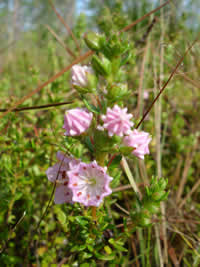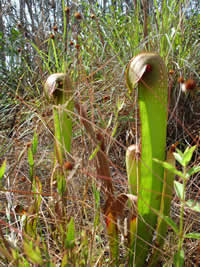USDA Forest Service Celebrating Wildflowers
|
|
|
Southern Region Viewing AreaRiverside IslandForest: National Forests in Florida, Ocala National Forest District: Lake George Ranger District Description: Riverside Island is one of the largest longleaf pine forests in Florida covering 9,257 acres. The term island refers to present day distribution of fragmented longleaf pine forest surrounded by a sea of sand pine/scrub forest. At one time longleaf pine ecosystem covered about 60 million acres stretching from southwest Virginia to Florida and to east Texas. Today less than 2% of longleaf pine ecosystem exists. Longleaf pine ecosystem is fire driven, with fires occurring at intervals of two to fifteen years. Native Americans and early settlers established communities in these islands because of the little occurrence of midstory vegetation. Riverside Island shows the least evidence of past human use, giving an impression of natural forest-like appearance. This open and airy forest is characterized by three dominant plant species: longleaf pine (Pinus palustris), wiregrass (Aristida stricta), and turkey oak (Quercus laevis). Visitors can enjoy walking in the Florida National Scenic Trail. This trail passes through a prairie/pond complex called Penner Ponds. Viewing Information: Species commonly found in Riverside Island include sandhill milkweed (Asclepias huministrata), butterfly weed (A. tuberosa), greeneye (Berlandiera subcaulis), hairy trilisa (Carphephorus paniculatus), butterfly-pea (Centrosema virginianum), goldenaster (Chrysopsis subulata), stinging nettle (Cnidusculus stimulosus), twinflower (Dyschoriste oblongifolia), Florida elephant’s-foot (Elephantopus elatus), Carolina rock-rose (Helianthemum carolinianum), gopherapple (Licania michauxii), rushweed (Lygodesmia aphylla), prickly-pear cactus (Opuntia humifusa), sand squares (Paronychia rugelii), blackroot (Pterocaulon pycnostachyum), Darrow’s blueberry (Vaccinium darrowii), shiny blueberry (V. myrsinitees), deerberry (V. stamineum). Safety First: Beware for black bear and gators. You can find information about bears and gators in our visitor centers located in the intersection of highway 40 and county road 315, and in the Salt Springs recreation area located on state route 19. Some trails in Riverside Island are designated for multiple purpose including off road vehicles (OHV). Depending on the time of year you may find biting insects. Take proper precautions such as insect repellant and long clothing. This area is extremely hot during summer; drink plenty of fluids. Further, protect yourself from the sun by using long clothing or sun block. Directions: From I-75 take highway 40 east to Ocala, drive approximately 10 miles to Silver Springs. Turn left (north) on county road 314 and left again on forest road 88. Go across county road 316; forest road 88 will change from paved to surfaced road. This is the south portion of Riverside Island. Ownership: United States Forest Service, National Forests in Florida, Lake George Ranger District, 17147 E. Highway 40, Silver Springs, FL 34488, (352) 625-2520. Closest town: Ocala, Florida. |
|
| NOTE: PDF format links require the Adobe Acrobat Reader to view. | |
| top | Disclaimers | FOIA | Privacy Policy | Quality of Information | Photo Credits & Use |
Location: http://www.fs.fed.us/wildflowers/regions/southern/RiversideIsland/index.shtml
Last modified: Tuesday, 24-Jun-2008 21:57:34 EDT

